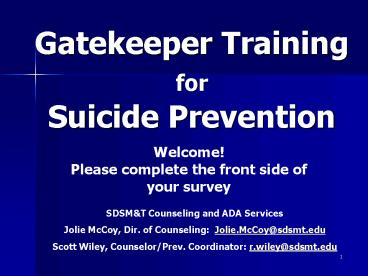Gatekeeper Training for - PowerPoint PPT Presentation
1 / 18
Title:
Gatekeeper Training for
Description:
WALL OF RESISTANCE. 8. Wall of Resistance to Suicide. Protective Factors. Calm Environment ... At the very least, if you observe warning signs in a student and become ... – PowerPoint PPT presentation
Number of Views:124
Avg rating:3.0/5.0
Title: Gatekeeper Training for
1
Gatekeeper Training for Suicide Prevention
Welcome! Please complete the front side of your
survey
SDSMT Counseling and ADA Services Jolie McCoy,
Dir. of Counseling Jolie.McCoy_at_sdsmt.edu Scott
Wiley, Counselor/Prev. Coordinator
r.wiley_at_sdsmt.edu
2
Student Suicide
- 10 attempted suicides at SDSMT in 04-05 school
year (431/100,000) - 100-125/100,000 attempted suicides for age 15-29
annually nationwide - 1088 college student suicides/year
- 2nd leading cause of death among college students
- Graduate students account for 32 of campus
suicides
3
- The federal government has declared suicide a
national health issue. - 1.5 million in grants made to campuses to design
and implement campus suicide prevention programs.
- Aim is to develop best practices that can be
used on campuses throughout the nation. - SDSMT is one of 22 schools (1st go-around)
awarded a grant to implement and evaluate a
program. - One aspect of our program is to train gatekeepers
in suicide prevention. - Nationally and through the courts, colleges and
universities are being asked to be more
pro-active in identifying and helping students
who are having emotional difficulties.
4
What is a Gatekeeper?
A person in a students life who may be in a
position to notice the student in distress and
intervene with help.
5
What signs of distress have you observed in
students?
6
College Students 17-24
- Change
- Identity
- Relationships
- Life Plan
- Angst
7
The Many Paths to Suicide
Hopeless- ness
Personal Risk Factors
Substance Abuse
Hx of Trauma or Abuse
Previous Attempt
Mental health
Family Hx of suicide
Increasing Hopelessness Contemplation of
Suicide as Solution
Environmental Risk Factors
Contagion effect
Social/ Relational loss
Access to Lethal means
Job/ Financial Loss
Demands w/o skills
WALL OF RESISTANCE
Stigma to help- seeking
Treatment Barriers
Social Cultural Risk Factors
Values Religion Beliefs
Lack of social support
Isolation
8
Wall of Resistance to SuicideProtective Factors
Access to medical services
Access to mental health services
Others?
Support for help-seeking
Medication Compliance
Good health
Calm Environment
Restricted access to lethal means
Pet(s)
Fear
sense of HOPE
Religious Prohibition
Responsibility for Children
Positive Self-steem
Job Security or Job Skills
Life skills (problem solving, conflict resolution)
Support of significant other(s)
AA or NA Sponsor
Best Friend(s)
-- Sobriety --
9
Warning Signs
? Withdraws doesnt interact with others
? Expresses hopelessness or feeling trapped
? Loses interest in hobbies, work, school, etc.
? Trouble eating or sleeping
? Increased use of alcohol or drugs
10
Warning Signs
Continued
- Expresses feelings of guilt, worthlessness,
self-loathing.
- Inappropriate or exaggerated behavior, rage,
aggressiveness, outbursts, crying
- Dramatic mood changes
- Acting reckless or engaging in risky activities
- Demonstrates anxiety or agitation
11
Urgent Warning Signs
? Announces he/she has made a plan to kill him-
or herself or somehow
? Reveals that he or she wants or intends to
commit suicide
? Seeking the means for suicide
? Making final arrangements (giving away prized
possessions)
? Talking or writing about suicide or death
12
Urgent Warning Signs
? Making statements like
?I wish I were dead
?Im going to end it all
?You will be better off without me
?Whats the point of living?
?Soon you wont have to worry about me
?Who cares if Im dead anyway?
?Im just going to drink myself to death
13
Dealing with a distressed student
- Take care of yourself
- Avoid escalation distressed students need
listening and support - Ask direct questions listen for ouch
- Dont assume youre being manipulated
- Know your limits
- Make a good referral
14
A direct intervention when you are concerned for
a persons safety
- TALK TO THEM. Take the time.
- Im worried about you
- Ive noticed youre acting differently
- Is everything OK?
- Have you had thoughts of hurting yourself?
- Are you thinking about suicide?
15
- LISTEN TO THEM
- Let them talk about whats going on
- Dont judge them or say You shouldnt feel that
way - Take any signs or threat of suicide seriously
16
- URGE THEM TO SEEK HELP
- Dont promise to keep a threat of suicide secret
- Getting help is strength not weakness
- I want you to live
- Im on your side well get through this
- Will you go with me to get help?
- Will you let me help you get help?
- Will you promise me not to kill yourself until
weve found some help?
17
Types of Referrals
- BEST Hand Delivered
- Personally take the person to someone who can
help - Next Best
- Get students commitment to accept help you
make the arrangements with student present - 3rd Best
- Give student referral information and try to get
a good faith commitment to seek help not
attempt suicide - Tell student you will contact the referral
resource to give them a heads up
18
- At the very least, if you observe warning signs
in a student and become concerned, please let
Counseling Services know of your concern.
19
Thank you!
- Please complete the reverse
- side of your survey































